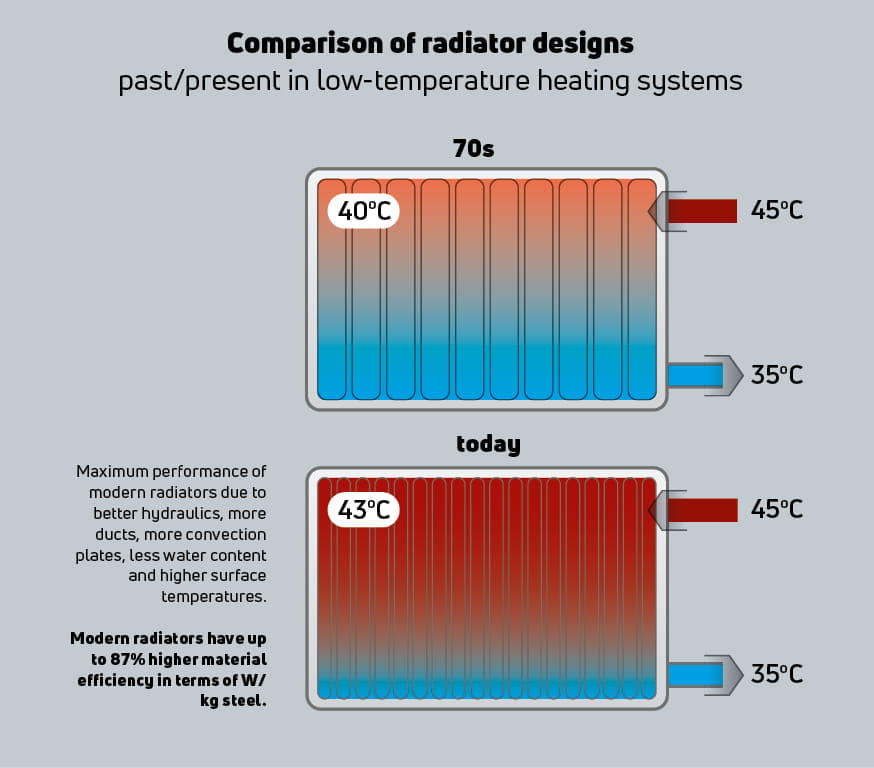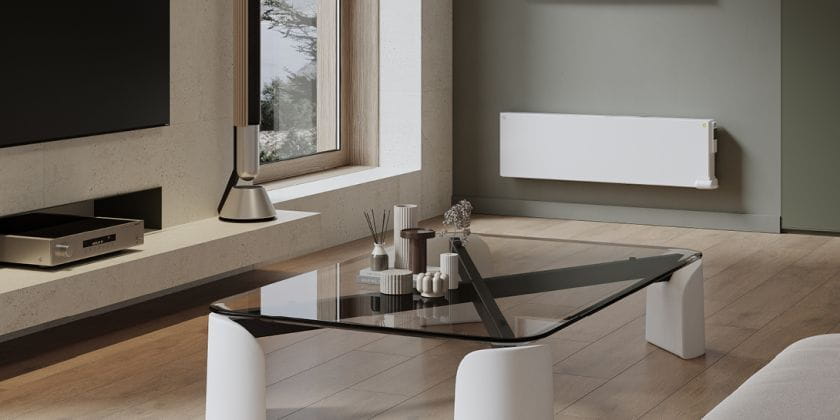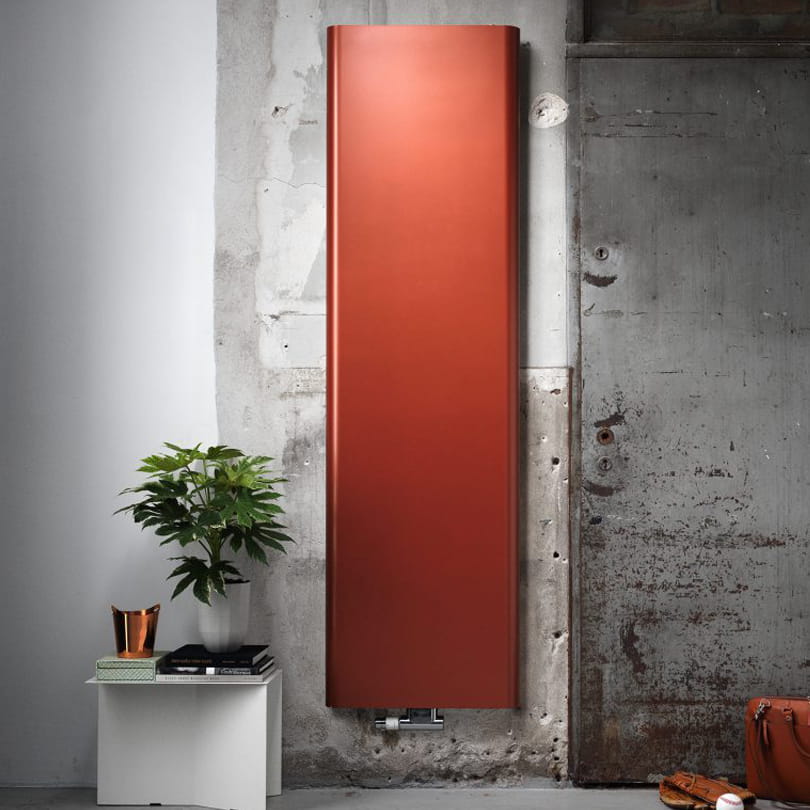- Radiators
- Insights
- Electrical heating
- Hydronic heating
- Renovation
A guide to radiator replacement
The reasons for a radiator replacement can be very diverse. Regardless whether it’s an aesthetic update or part of a heating system renovation, replacing a radiator with the best possible fit ensures you’re set for years to come. This guide elaborates on the technical improvements you enjoy when replacing old radiators and provides insights into the various factors affecting a radiator replacement along with access to a comprehensive overview of which radiators are best suited to which application.
Why replace radiators?
In general radiators don’t get replaced very often. They have a long lifespan and often blend so well into the interior that we even forget they’re there. However, replacing old radiators with new ones can yield several benefits. Especially because today’s modern radiators are specially designed for low temperature heating. There are now fan-assisted radiators and fan convectors, for example, that can be operated at temperatures below 45°C, which makes them a perfect match for low temperature heat sources such as a heat pump or modern condensing boiler.
Both hydronic and electric panel radiators have come a long way since the clunky heating elements of 50 years ago. To increase the performance of hydronic radiators, for example, they are equipped with narrower water channels as well as more and larger convector fins for more rapid heat response. Modern radiators have up to 87% higher material efficiency in relation to W/kg steel.

Electric radiators have seen many improvements as well. Not only the shape of the radiators and the materials have improved, but also smart features such as presence detection or open window detection have been added. Not forgetting about the controls that have progressed from a simple on/off switch to smart systems that allow for connectivity with home automation systems and intuitive apps on our smartphone.
A radiator replacement is therefore very beneficial for the overall efficiency of a heating system and the indoor climate comfort. Even more so when an old boiler is replaced by a modern one or a heat pump to create a low temperature system. In that case it’s vital that the radiators are reviewed and sized according to the new heat source to ensure optimal performance.
Read more about low temperature radiators for heat pumps
Replacing a radiator with the best possible match
As well as being more efficient, new radiators can also enhance the interior design of any room. Thanks to the many models, heights, configurations and colours available today, it’s very easy to create added value by replacing a radiator. There is a match for every space, style and budget.
Some people hesitate to replace their old radiators, for example, because they want to maintain the vintage style of their interior. However, radiators such as our Delta column radiators perfectly combine modern technology with a retro look. Like many of our radiators, they are available in over 70 different colours so it’s easy to find a radiator that blends in with the interior’s colour scheme or stands out if you want to create an eye-catcher.
Vertical radiators are another good example of how a radiator replacement can help to optimise an interior design. Replacing a horizontal radiator by a vertical one will instantly transform the look-and-feel of a room and create more design freedom by leaving wall space available that can then be used for other purposes.
Read about the reasons why vertical radiators stand out
Vertical radiators are a good example of how a radiator replacement can help to optimise an interior design.
Radiator replacement & pipes
An important factor to consider in any radiator replacement is the existing pipe network. Provided that the distances between the pipes fit and the valves are designed according to standards, replacing a radiator is rather clear-cut. However, we are aware that a radiator replacement is not always this straightforward and that finding a radiator that caters to the end user’s taste as well as fits the existing pipes can be a challenge.
That is why flexibility is top of mind when we design our radiators. Several of our radiators incorporate both side and bottom connection options. Our Ulow-E heat pump radiator, for example, can easily serve as a replacement for older Ventil and Compact radiators without having to change the pipe system. It has six possible connection options; the standard bottom right connection can conveniently be turned into a bottom left connection by rotating the radiator 180 degrees. On top of that, there are four options to install the radiator on existing pipes from the sides with a lateral or diagonal connection.
Our Flex radiators, in turn, offer maximum flexibility in terms of the preferred radiator dimensions thanks to their middle connection. Moreover, their modern design allows you to freely choose the mounting side of the thermostatic head; on the right or on the left side of the radiator.
Safe radiator replacements
When replacing a radiator safety is of course also an important factor to consider. The matching radiator brackets supplied with the radiator ensure that safety is always the top priority, regardless of whether it is a first-time installation or a radiator replacement. The VDI guideline 6036 provides a basis for the selection of other suitable fixing systems. In addition to the mounting brackets, the wall condition and its load-bearing capacity must also be checked.
Read more about the role of radiator brackets in safe installations
Replacing electric radiators
Compared to hydronic radiators, electric radiators are easier to replace. In a small house, for example, it will only take around a day to replace all electric radiators. That said, it remains very important that all fixed electrical installations are carried out by a qualified electrician. He or she will be able to determine the heat demand as well as the correct heat capacity of the electric radiators. Replacing old electric radiators with new ones will not only provide considerable energy savings, but will also improve the indoor air quality due to reduced dust burning and a better ionisation balance.
Read more about replacing old electric radiators to improve the indoor climate

Replacing old electric radiators with new ones will provide considerable energy savings and improve the indoor air quality.
Choosing the right radiator for replacements
Whether you’re simply replacing a bathroom radiator, updating the emitters in a living room or renovating an entire heating system, there are always multiple possibilities for a radiator replacement. To help you see the wood for the trees, we have created a comprehensive overview showing which radiators are best suited to which application.
Whatever the reason for the radiator replacement: energy-saving, aesthetics, low temperature or otherwise, we offer a solution. As a total heating solutions provider, we are happy to support you with unbiased options and advice on the most effective indoor climate solutions, integrating mixed system layouts for maximum efficiency.


